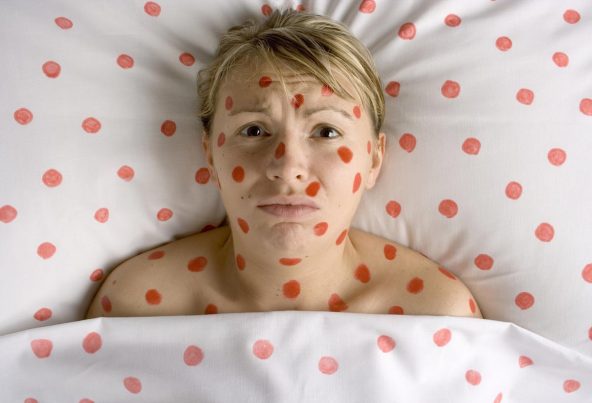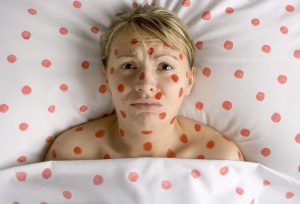
Rubella – causes, side effects and treatments at NaturalPedia.com
Tuesday, June 19, 2018 by Michelle Simmons
http://www.naturalpedia.com/rubella-causes-side-effects-and-treatments-at-naturalpedia-com.html

Also known as German measles, rubella is an acute, contagious infection caused by the rubella virus. The rubella virus, which belongs to the family of the Toga virus, usually causes a rather mild illness, circulates widely in South Africa and internationally each year. Rubella most often occurs in children and young adults. It usually affects the skin, causing a typical rash. The word rubella in Latin means “little red” and the disease features a red rash. This infection also affects the lymph nodes.
The term German measles, the alternative name of rubella, was used because German physicians wrote the first clear description of it in 1760. Rubella can spread when people breathe in small droplets of fluid carrying the virus, or when a person with rubella sneezes or coughs. It can also spread by infected people eating from the same utensils or drinking from a cup or glass with someone else.

Known side effects of rubella
The side effects of rubella typically appear 14 to 21 days after infection. The rash, which can be itchy, often starts on the face and moves to the trunk and limbs. After three to five days, it fades and goes away. Other side effects include a stuffy nose, headache, a mild fever, red, inflamed eyes, nerve inflammation, enlarged and tender lymph nodes, and aching joints.
Approximately 70 percent of women who get rubella may experience arthritis. In rare cases, rubella can cause serious problems, such as brain infections and bleeding problems. Although rubella is almost always a mild disease in children, it may be dangerous in pregnant women. A pregnant woman infected with the rubella virus can pass the virus on to her fetus, which can lead to miscarriage, stillbirth, or congenital rubella syndrome in babies. The baby can also develop other serious birth defects, such as heart problems, loss of hearing and eyesight, intellectual disability, and liver or spleen damage. Serious birth defects are more common if a woman is infected early in her pregnancy, especially in the first trimester.
Body systems harmed by rubella
The body systems harmed by rubella include the integumentary and lymphatic systems.
List of foods or nutrients that prevent rubella
There is no information on what foods or nutrients prevent rubella.
Treatments, management plans for rubella
Like other viral infections, there is no treatment for the rubella virus. Once infected with the disease, the only thing to do is to wait for the disease to go away on its own. Treatment is more focused on relieving discomfort from the symptoms.
Natural remedies for rubella include the use of neem leaves, or leaves of the margosa tree, in order to provide relief from the rash and discomfort that rubella brings. Soak some leaves in a bucket or tub for a few hours and bathe in this water. Other home remedies for rubella include echinacea, turmeric, licorice, orange, and lemon.
Where to learn more
- Inaccurate And Misleading Vaccine Data (Agnotology) As Admitted To By Industry Insider
- VACCINE HOAX unveiled as rigorous scientific study finds NO reduction in measles, mumps, rubella, influenza or rotavirus among vaccinated children
- (Un) Informed Consent: A few things parents don’t know about the measles, mumps & rubella vaccine – Part 1
- Dr. Kurt: why I will never choose to vaccinate my own son and any future kids my wife and I have
- VACCINE QUACKERY BOMBSHELL: Key studies cited to ‘prove’ vaccines are safe were funded almost entirely by vaccine manufacturers
Summary
Rubella is an acute, contagious infection caused by the rubella virus.
Rubella causes an itchy rash, a stuffy nose, headache, a mild fever, red, inflamed eyes, nerve inflammation, enlarged and tender lymph nodes, and aching joints.
Rubella can be dangerous in pregnant women and the baby. It can cause miscarriage, stillbirth, or congenital rubella syndrome in babies. The baby can also develop birth defects, such as heart problems, loss of hearing and eyesight, intellectual disability, and liver or spleen damage.
Treatments for rubella are focused on relieving its symptoms. Natural remedies for the disease include neem leaves, echinacea, turmeric, licorice, orange, and lemon.
Sources include:
Tagged Under: Tags: rubella





